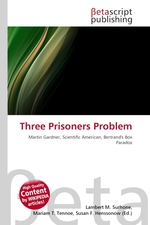Three Prisoners Problem
Lambert M. Surhone, Miriam T. Timpledon, Susan F. Marseken
бумажная книга
High Quality Content by WIKIPEDIA articles! The Three Prisoners problem appeared in Martin Gardner's Mathematical Games column in Scientific American in 1959. It is mathematically equivalent to the Monty Hall problem with car and goat replaced with freedom and execution respectively, and also equivalent to, and assumedly based on, Bertrand's box paradox. Out of three prisoners scheduled to be executed, A, B, and C, one of them will be pardoned. A asks the warden to tell him the name of one of the others who will be executed. As the question is not directly about A's fate, the warden obliges — either naming the other prisoner to be executed, if A is the one, or secretly flipping a coin to decide which of the remaining names to give A if A is the one being pardoned. Assuming the warden's truthfulness, there are now only two possibilities for who will be pardoned: A, and whichever of B or C the warden did not name. Did A gain any information as to his own fate, that is, does he change his estimate of the chances he will be pardoned? To make the analogy to the Monty Hall problem more explicit: if the warden says "B will be executed" and A could switch fates with C, should he?
Данное издание не является оригинальным. Книга печатается по технологии принт-он-деманд после получения заказа.


